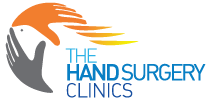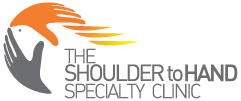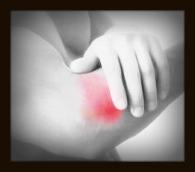Disclaimer:
The Hand Surgery Clinics blog provides information of a general nature about the specialty of Hand and Upper Extremity Surgery. The information is provided with the understanding that Hand Surgery Clinics is not engaged in rendering hand surgery medical advice or recommendations. Any information on the blog should not be considered a substitute for consultation with a qualified hand surgeon to address individual medical needs. Your particular facts and circumstances will determine the hand surgery treatment which is most appropriate for you.
Lateral epicondylitis (tennis elbow) is a painful condition involving the tendons that attach to the bone on the outside (lateral) part of the elbow.
Tendons anchor the muscle to bone. The muscle involved in this condition, the extensor carpi radialis brevis, helps to extend and stabilize the wrist.
With lateral epicondylitis, there is degeneration of the tendon’s attachment, weakening the anchor site and placing greater stress on the area. This can then lead to pain associated with activities in which this muscle is active, such as lifting, gripping, and/or grasping. Sports such as tennis are commonly associated with this, but the problem can occur with many different types of activities, athletic and otherwise.
Cause
Tennis elbow is caused by repeated use of the forearm muscles that extend your wrist and fingers. The repeated stress to the tissue may cause tiny tears in the tendons that attach to the outside of the elbow.
Any activity repeatedly done with palms facing downward can cause tennis elbow. These activities include:
• Repetitive tasks such as typing, using tools etc.
• Prolonged gripping tasks such as riding a motorcycle or a bicycle, pushing or carrying heavy loads.
Trauma – A direct blow to the elbow may result in swelling of the tendon that can lead to degeneration. A sudden extreme action, force, or activity could also injure the tendon.
Who gets it?
The most common age group that this condition affects is between 30 to 50 years old, but it may occur in younger and older age groups, and in both men and women.
Signs and Symptoms
Pain is the primary reason for patients to seek medical evaluation. The pain is located over the outside aspect of the elbow, over the bone region known as the lateral epicondyle. This area becomes tender to touch. Pain is also produced by any activity which places stress on the tendon, such as gripping or lifting. With activity, the pain usually starts at the elbow and may travel down the forearm to the hand. Occasionally, any motion of the elbow can be painful. Tennis elbow pain can appear slowly or suddenly. Symptoms can include:
Treatment
Home care:
You may try these methods to care for tennis elbow:
Activity modification and rest– Initially, the activity causing the condition should be limited. Limiting the aggravating activity, not total rest, is recommended.
Medication – anti-inflammatory medications may help alleviate the pain.
Brace – a tennis elbow brace, a band worn over the muscle of the forearm, just below the elbow, can reduce the tension on the tendon and allow it to heal.
Taping — Tape your elbow to help provide support to the soft tissues. Seek the help of a physical or occupational therapist to show you how to tape your elbow.
Ice application— using ice several times daily can relieve pain.
– Ice pack application. Place a towel between your skin and the ice pack. Leave the ice pack on the painful area for 10-15 minutes. Check your skin every five minutes to ensure you are not injuring your skin.
– Ice massage. Using an ice pack, massage directly on the outside of your elbow in a circular motion for about 5 minutes.
– Manual massage. Massage may help increase blood flow, reduce sensitivity and relieve pain. Ask a physical or occupational therapist to show you how to perform massage.
Exercises
Stretching and strengthening can be effective treatments for tennis elbow. The goal of exercising is to strengthen the muscles to prevent pain and promote a healthy recovery.
Forearm extensor stretch
1. Hold the affected arm out in front of you with the elbow slightly bent.
2. Curl the fingers of your affected arm and place your other hand over the knuckles. Gently pull the hand and wrist of the affected arm inward until you feel a slight stretch along your arm. You should feel some tension along your arm, but do not pull so hard that your arm hurts.
Eccentric wrist extensor strengthening
1. Rest your affected arm on a table, allowing your hand to hang freely over the edge.
2. Use the other hand to lift the hand of the affected arm until the hand is raised. Hold the hand in this position while you release the helping hand.
3. Slowly allow the hand of your affected arm to lower back to the position of hanging freely. This slow movement is called a “controlled release” or an “eccentric muscle contraction.”
Isometric wrist extensor strengthening
1. Rest your affected arm on a flat surface holding your wrist out straight over the edge.
2. Use the other hand to apply a downward pressure on the hand of the affected arm while keeping the wrist out straight.
Isotonic wrist extensor strengthening
1. Rest your affected arm palm down on a table or your lap allowing your hand to hang over the edge.
2. Bend your wrist to raise your hand up, then down.
Other treatments for tennis elbow include electrical stimulation, iontophoresis and ultrasound. Depending on the severity and duration of your symptoms, you may benefit from these treatments. Your physician and therapist can identify the best methods to help you manage your condition.
Steroid injections – A steroid is a strong anti-inflammatory medication that can be injected into the area. No more than 2-3 injections should be given. Please consult your physician to discuss this option.
Surgery
Surgery is only considered when the pain is incapacitating and has not responded to conservative care, and symptoms have lasted more than six months. Surgery involves removing the diseased, degenerated tendon tissue. Arthroscopic (key hole surgery) and traditional open surgical techniques are utilized to treat tennis elbow.


